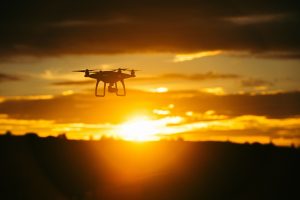
The popularity of drones among hobbyists and industry has skyrocketed in the last few years and is expected to continue. In the United States, the Federal Aviation Administration (FAA) predicts the number of hobbyist drones operating will more than triple from 1.1 million in 2016 to 3.5 million in 2021. Commercial drone revenues are expected to grow to $13 billion by 2025, an increase from $5.8 billion in 2018.
Monitoring wildfires and crops, inspecting pipelines and property damage, providing aerial photography for cinematographers and journalists, helping to find missing people or simply providing hobbyists hours of enjoyment, most of those who operate drones do so lawfully. However, as drones become less expensive, smaller, and more sophisticated the concern that they will be used by those seeking to do harm increases.
In 2014, there were 143 near mid-air collisions in the United States. Near mid-air collisions (NMACs) are defined as aircraft flying within 500 feet of another aircraft. In 2017, NMACs totaled 385. According to the FAA, more than half of NMACs are due to drones. Unauthorized video surveillance of worksites, of government facilities or of someone’s residence threatens both national security and personal privacy. Todd Probert, vice president of Raytheon Intelligence, Information and Services states that some of his company’s defense customers liken “drones to the improvised explosive device (IED) situation 20 years ago…when an adversary [took] a readily available technology and weaponize[d] it in a low-cost way.”
As a result of this threat, public safety and defense departments around the world are spending hundreds of millions of dollars on anti-drone technology. As this week’s market size shows, the amount spent is expected to increase into the billions by the mid-2020s. Anti-drone technology has a triple purpose: detect, track and destroy. Many drones use a radio frequency command and control link, therefore drone detection and tracking systems also use radiofrequency but this type of detection is combined with electro-optical and infrared sensors, radar, or acoustics. Once an unauthorized drone is detected, tracked and determined to be a threat, the most common types of technology used to destroy the drone are lasers, missiles, and electronic countermeasure systems. Laser systems direct energy to critical parts of a drone’s airframe causing it to crash. Low-power lasers are used to destroy the electro-optical sensors on the drone causing it to stop working. Seeker missiles that have a long range can be directed to destroy an individual drone or multiple drones in a particular area long before they reach their target. Electronic countermeasures use microwave or electromagnetic signals to block data transmission between the drone and its operator. It can also disrupt the drone’s GPS navigation system. Anti-drone systems provide multi-layer protection.
Destructive anti-drone systems provide most of the revenue in this industry, with laser systems accounting for a majority of the revenue within this category. This is expected to continue at least through 2026. The majority of anti-drone systems are sold to the military and defense departments. Rising incidents of illegal and terrorist activities worldwide, including smuggling contraband, are expected to increase demand for anti-drone technology. Commercial adoption of these systems at airports, prisons, live events and around critical infrastructure is also expected to increase. A large number of companies develop anti-drone systems. Some of the leading developers include Dedrone GmbH, Advanced Radar Technologies, Droneshield, Thales Group, Blighter Surveillance Systems, Airbus Group SE, and The Boeing Company, in addition to Raytheon.
Geographic reference: WorldYear: 2018 and 2026
Market size: $576.7 million and $4.5 billion, respectively
Sources: “Anti-drone Market Size, Share & Trends Analysis Report by Mitigation Type, by Defense Type (Detection & Disruption, Detection), by End Use (Military & Defense, Commercial), and Segment Forecasts, 2019 – 2026,” Grand View Research, May 2019 available online here; “The Global Anti-drone Market Size Is Expected to Reach USD 4.5 Billion by 2026, Expanding at a CAGR of 29.9% from 2019 to 2026,” Cision PR Newswire, June 17, 2019 available online here; Sally Cole, “Counter-drone Technologies are Evolving to ‘Counter’ Countermeasures,” Military Embedded Systems available online here; I. Wagner, “Commercial UAVs – Statistics & Facts,” Statista, January 11, 2019 available online here; Eric Till, “Drone Industry Statistics,” Drone Base, May 13, 2018 available online here; Miriam McNabb, “Diving Into the FAA Administrator’s Fact Book: Why ‘Drone Incidents’ are Concerning for Regulators,” Drone Life, August 19, 2019 available online here; “Commercial Drone Market Size, Share & Trends Analysis Report by Application (Filming & Photography, Inspection & Maintenance), by Product (Fixed-wing, Rotary Blade Hybrid), by End Use, and Segment Forecasts, 2019 – 2025,” Grand View Research, June 2019 available online here.
Image source: StockSnap, “mountain-sky-clouds-nature-drone-2574006,” Pixabay, August 2, 2017 available online here.
